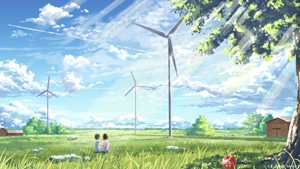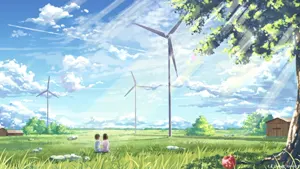
Sustainable Development
Sustainable Development and Technology
![]() The term sustainable development is the wider term used to define a variety of global problems, such as the pollution of our environment, climate change, fossil fuel burning, ecological and forestry devastation and grouping them together under a single entity to create a self-sustainable development strategy based on 100 per cent of renewable energy and 100 per cent organically grown agriculture.
The term sustainable development is the wider term used to define a variety of global problems, such as the pollution of our environment, climate change, fossil fuel burning, ecological and forestry devastation and grouping them together under a single entity to create a self-sustainable development strategy based on 100 per cent of renewable energy and 100 per cent organically grown agriculture.
We all know that power plays an important role wherever man works or lives, but the increasing demand for power, depleting fossil fuel resources and the growing environmental pollution that burning fossil fuels brings, has led the world to rethink its future strategy about renewable sources of energy. Sustainable development can bring about a clean and adequate supply of energy for all if organised correctly.

Although sustainable development or simply “sustainability”, is an all encompassing concept, the march forward in the global and local economic activities for the production of goods and services as well as fuels used for transportation and energy production, must be pursued without causing irreparable damage to the world’s ecology and the environment.
The sustainable use of bioenergy and biofuels is contributing to alleviate climate change by replacing fossil fuels with fast growing energy crops, thus helping to reduce greenhouse gas emissions present in the world’s energy system. But a sustainable energy system must be part of a general process of sustainable development to ensure that the extensive use of biomass and bioenergy products is not at the expense of other sustainable activities.
What is Sustainable Development
But what is sustainable development and how do sustainable technologies help build a better environment and quality of life.
In 1987 the World Commission on Environment and Development (WCED) released a document known as the Brundtland Report, after Gro Harlem Brundtland, which popularized the concept of sustainable development by stating that: sustainable development is development that meets the needs of the present without compromising the ability of future generations to meet their own needs.
While this WCED statement is somewhat vague and does not reference the environment directly, it is intended to guide developing countries into achieving their sustainable development goals as well as forcing the more industrialised countries into achieving full compliance with their quotas in reducing greenhouse gas emission more cost-effectively. From this statement originates the fundamental ethical principle that “the responsibility of present generations to future generations” with regards to the well-being of all peoples as an environmental quality.
Energy generation and its use are heavily linked to all forms of sustainable development, economic, social, and environmental. The availability of alternative and renewable forms of energy around the world are many thousands of times larger than those man produces by burning fossil fuels energy alone, the challenge here is how we can use these resources in an environmentally friendly and acceptable way.
The main choices for using energy in the ways that both support and promote sustainable development are:
- The more efficient use of energy by end user in their homes and work places.
- The reduction in wasted energy by the use of energy-management systems to optimise processes.
- Increase in recycling and reuse to reduce energy consumption needed to collect, recover, and transport waste.
- The increase in a products life-cycle or its ability to be 100% recycled or reused.
- The increased use of renewable energy sources such as solar panels and wind turbines.
- The increased development and instalment of new and more advanced energy technologies.
As this short list may seem, well short and obvious, reducing the negative environmental impacts of conventional energy on the environment through the use of cleaner low carbon coal or increased use of waste-to-energy fuels can go a long way to a sustainable development plan and for reducing those adverse environmental impacts.
Technology for Sustainable Living
Technology plays an important role in our daily lives and it can be put to good use to provide us with a sustainable future. Many people associated with sustainable development put great faith in the power that technology has to improve the production and efficiency with which energy resources are used. Technology for sustainable living plays a crucial role in achieving significant changes in our everyday lives.
Electrical power generation is one of several different reasons for building large dams. Hydroelectric and pump storage power schemes are strongly site specific but are able to regulate their electrical power output within a few seconds, making them an ideal technology for the generation of power to the grid.
Many people rate hydro-power as being less harmful to the environment than burning fossil or nuclear power. This is in main, because they believe that the positive impacts of hydropower being a renewable, clean, reliable, carbon free in most part, and offering a flexible peak-load technology outweighs the local negative impacts of hydro-power.
While hydroelectric power has a great future, it can divert funds away from other forms of sustainable development and technologies. Today, science and technology is used to increase both the productivity and the profitability of homes and businesses around the world. Sustainable technologies can provide a pollution free, renewable environment with the use of solar panels and wind turbines creating local employment in their design and installation.
Design and development of sustainable towns and cities is on the increase with environmentally sustainable neighbourhoods allowing people to live in a more sustainable way without having to actively choose to be green. The inhabitants can choose their energy supplier and whether they want to buy from a renewable and sustainable energy supplier. Utility companies are now offering blue (water), yellow (solar) and green (biomass) electricity and heating where the energy is delivered from local renewable sources.
As part of the sustainable development of an area, waste, greywater and sewage is collected and processed locally either being recycled or converted into fertilizers for the local farmland. Passive houses, energy positive houses and buildings can reduce the amount of energy need to heat and cool them. Green roof technology can be used on buildings as part of a rainwater harvesting and water management system.
Towns and cities are built for people to live in and work, which also means that the same people at all levels must be prepared to engaged in building more sustainable environments and to reduce the emissions of greenhouse gases that are linked directly to the consumption of goods and services and, above all, to their production and supply. That way we can build new neighbourhoods in our towns and cities were the infrastructure facilitates a “greener” lifestyle without lowering the quality of life for the residents.
Tutorial Summary
We have seen here that the term sustainable development was defined in the Brundtland report in 1987 as a: “development that meets the needs of the present without compromising the ability of future generations to meet their own needs”. The development of nations and population growth adversely affects our sustainability future by increasing the use of the worlds energy resources and environmental degradation.
The world’s natural resources are finite and must therefore be managed accordingly. All types of fossil fuels are considered to be unsustainable because someday they will reach the point of depletion when they will become uneconomic to extract or produce. Then we need to look at ways of producing and using sustainable forms of energy that will support long-term human development in all its economic, social and environmental forms.
Sustainable development is the ability of a nation or society to continue with its present rate of energy consumption and production many generations into the future. A sustainable energy market requires that the quality, quantity and availability of energy improves as energy becomes more affordable, more reliable, usable and cleaner over time.
To learn more about sustainable development, or if you just want to explore the advantages and disadvantages of how sustainability works, then Click Here to get your copy of one of the top books on sustainable development today direct from Amazon and learn how the technology for sustainable living need not cost the Earth.











Nice blog to read
Good article, but we need to look at the bigger picture of sustainable development as coal has been the economic lifeline of many countries around the world for many decades. Switching from coal to renewables is time consuming and expensive.